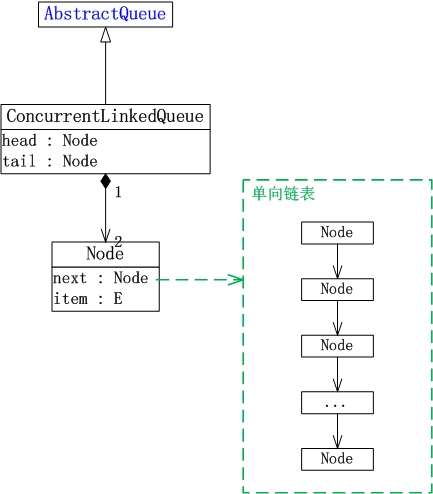描述
ConcurrentLinkedQueue是一个基于单链表的无界线程安全队列,该队列是FIFO的。ConcurrentLinkedQueue/ConcurrentLinkedDeue和LinkedBlockingQueue/LinkedBlockingDeue
相比,不同点在于它们是non-blocking的,并且是lock-free的,而后者则是利用ReentrantLock实现的,所以他们具有更高的吞吐量。
源码解析(基于jdk1.8.0_40)
数据结构
类图:
head,tail结点定义和描述:
/**
* A node from which the first live (non-deleted) node (if any)
* can be reached in O(1) time.
* Invariants:
* - all live nodes are reachable from head via succ()
* - head != null
* - (tmp = head).next != tmp || tmp != head
* Non-invariants:
* - head.item may or may not be null.
* - it is permitted for tail to lag behind head, that is, for tail
* to not be reachable from head!
*/
private transient volatile Node<E> head;
/**
* A node from which the last node on list (that is, the unique
* node with node.next == null) can be reached in O(1) time.
* Invariants:
* - the last node is always reachable from tail via succ()
* - tail != null
* Non-invariants:
* - tail.item may or may not be null.
* - it is permitted for tail to lag behind head, that is, for tail
* to not be reachable from head!
* - tail.next may or may not be self-pointing to tail.
*/
private transient volatile Node<E> tail;
链表结构
构造函数,初始化时让head和tail同时指向一个dummy结点(否则入队时需要同时修改head,tail 2个指针,需要加锁。而有了dummy结点,入队/出队只需各自竞争一个资源即可--入队CAS竞争修改头结点item属性:p.casItem(item, null),出队CAS竞争修改尾结点next指针:p.casNext(null, newNode)):
/**
* Creates a {@code ConcurrentLinkedQueue} that is initially empty.
*/
public ConcurrentLinkedQueue() {
head = tail = new Node<E>(null);
}ConcurrentLinkedQueue中单链表结构示意图:
*
* head tail
* | |
* v v
*
* +------+ +------+ +------+
* |dummy |------>| a | ... ----->| n |----->null
* +------+ +------+ +------+
*注意head和tail指针不是一定要每次更新的,事实上它们的更新是迟钝的,有滞后的(这样有助于减少CAS操作,jdk7中,head/tail指针在滞后实际的头/尾结点2步以上时才会更新,甚至会发生tail指针滞后于head指针)。真正的尾结点可以通过tail指针向后找,直到node.next==null。同样真正的队列头结点可以通过head指针向后找,直到node.item!=null。下面的描述来自ConcurrentLinkedQueue Node类的doc文档:
* Both head and tail are permitted to lag. In fact, failing to
* update them every time one could is a significant optimization
* (fewer CASes). As with LinkedTransferQueue (see the internal
* documentation for that class), we use a slack threshold of two;
* that is, we update head/tail when the current pointer appears
* to be two or more steps away from the first/last node.
*
* Since head and tail are updated concurrently and independently,
* it is possible for tail to lag behind head (why not)?入队offer方法
从队尾入队,找到队尾结点p后,cas竞争更新p.next指针,选择性的更新tail指针(前面提到的滞后更新)。
/**
* Inserts the specified element at the tail of this queue.
* As the queue is unbounded, this method will never return {@code false}.
*
* @return {@code true} (as specified by {@link Queue#offer})
* @throws NullPointerException if the specified element is null
*/
public boolean offer(E e) {
checkNotNull(e);
final Node<E> newNode = new Node<E>(e);
for (Node<E> t = tail, p = t;;) {
Node<E> q = p.next;
if (q == null) {
// p is last node
if (p.casNext(null, newNode)) {
// Successful CAS is the linearization point
// for e to become an element of this queue,
// and for newNode to become "live".
if (p != t) // hop two nodes at a time
casTail(t, newNode); // Failure is OK.
return true;
}
// Lost CAS race to another thread; re-read next
}
else if (p == q)
// We have fallen off list. If tail is unchanged, it
// will also be off-list, in which case we need to
// jump to head, from which all live nodes are always
// reachable. Else the new tail is a better bet.
p = (t != (t = tail)) ? t : head;
else
// Check for tail updates after two hops.
p = (p != t && t != (t = tail)) ? t : q;
}
}出队poll方法
从队列头部出队,找到头部结点p后,cas竞争把p.item值置null,选择性的更新head指针(前面提到的滞后更新)。注意head,tail指针始终不会为null,即使出队后队列空了,head和tail也会指向dummy结点。
public E poll() {
restartFromHead:
for (;;) {
for (Node<E> h = head, p = h, q;;) {
E item = p.item;
if (item != null && p.casItem(item, null)) {
// Successful CAS is the linearization point
// for item to be removed from this queue.
if (p != h) // hop two nodes at a time
updateHead(h, ((q = p.next) != null) ? q : p);
return item;
}
else if ((q = p.next) == null) {
updateHead(h, p);
return null;
}
else if (p == q)
continue restartFromHead;
else
p = q;
}
}
}updateHead方法,cas更新head指针,并通过h.lazySetNext(h),把出队的结点h的next指针指向h自己,标示出已经出队(虽然已经通过设置node.item为null标示,但这里修改next指针是为了帮助GC):
/**
* Tries to CAS head to p. If successful, repoint old head to itself
* as sentinel for succ(), below.
*/
final void updateHead(Node<E> h, Node<E> p) {
if (h != p && casHead(h, p))
h.lazySetNext(h);
}size方法
size(), contains(), toArray()方法都需要遍历整个链表。
/**
* Returns the number of elements in this queue. If this queue
* contains more than {@code Integer.MAX_VALUE} elements, returns
* {@code Integer.MAX_VALUE}.
*
* <p>Beware that, unlike in most collections, this method is
* <em>NOT</em> a constant-time operation. Because of the
* asynchronous nature of these queues, determining the current
* number of elements requires an O(n) traversal.
* Additionally, if elements are added or removed during execution
* of this method, the returned result may be inaccurate. Thus,
* this method is typically not very useful in concurrent
* applications.
*
* @return the number of elements in this queue
*/
public int size() {
int count = 0;
for (Node<E> p = first(); p != null; p = succ(p))
if (p.item != null)
// Collection.size() spec says to max out
if (++count == Integer.MAX_VALUE)
break;
return count;
}succ方法,寻找后继结点(通过判断p==p.next来跳过已经出队的结点):
/**
* Returns the successor of p, or the head node if p.next has been
* linked to self, which will only be true if traversing with a
* stale pointer that is now off the list.
*/
final Node<E> succ(Node<E> p) {
Node<E> next = p.next;
return (p == next) ? head : next;
}相关内容链接
聊聊并发(六)——ConcurrentLinkedQueue的实现原理分析 (基于jdk1.6的源码解析)
